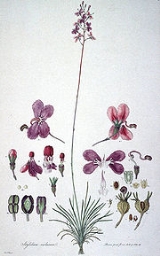
Stylidium violaceum
Encyclopedia
Stylidium violaceum is a dicotyledon
ous plant
that belongs to the genus
Stylidium (family Stylidiaceae
). S. violaceum is endemic
to Australia
and is found primarily in the southwestern region of Western Australia
. It can grow up to 50 cm including the scape
. The mostly purple flowers are 10 mm tall and 6 mm broad. Leaves are 5 cm long and about 4 mm broad. Flowering occurs mainly from October to January. S. violaceum is found in locations with sandy or loamy sand soil texture
conditions on hillslopes, dunes, or winter wet depressions and swamps.
Dicotyledon
The dicotyledons, also known as dicots, are a group of flowering plants whose seed typically has two embryonic leaves or cotyledons. There are around 199,350 species within this group...
ous plant
Plant
Plants are living organisms belonging to the kingdom Plantae. Precise definitions of the kingdom vary, but as the term is used here, plants include familiar organisms such as trees, flowers, herbs, bushes, grasses, vines, ferns, mosses, and green algae. The group is also called green plants or...
that belongs to the genus
Genus
In biology, a genus is a low-level taxonomic rank used in the biological classification of living and fossil organisms, which is an example of definition by genus and differentia...
Stylidium (family Stylidiaceae
Stylidiaceae
The family Stylidiaceae is a taxon of dicotyledonous flowering plants. It consists of five genera with over 240 species, most of which are endemic to Australia and New Zealand. Members of Stylidiaceae are typically grass-like herbs or small shrubs and can be perennials or annuals...
). S. violaceum is endemic
Endemic (ecology)
Endemism is the ecological state of being unique to a defined geographic location, such as an island, nation or other defined zone, or habitat type; organisms that are indigenous to a place are not endemic to it if they are also found elsewhere. For example, all species of lemur are endemic to the...
to Australia
Australia
Australia , officially the Commonwealth of Australia, is a country in the Southern Hemisphere comprising the mainland of the Australian continent, the island of Tasmania, and numerous smaller islands in the Indian and Pacific Oceans. It is the world's sixth-largest country by total area...
and is found primarily in the southwestern region of Western Australia
Western Australia
Western Australia is a state of Australia, occupying the entire western third of the Australian continent. It is bounded by the Indian Ocean to the north and west, the Great Australian Bight and Indian Ocean to the south, the Northern Territory to the north-east and South Australia to the south-east...
. It can grow up to 50 cm including the scape
Scape (botany)
In botany, scapes are leafless flowering stems that rise from the ground. Scapes can have a single flower or many flowers, depending on the species....
. The mostly purple flowers are 10 mm tall and 6 mm broad. Leaves are 5 cm long and about 4 mm broad. Flowering occurs mainly from October to January. S. violaceum is found in locations with sandy or loamy sand soil texture
Soil texture
Soil texture is a qualitative classification tool used in both the field and laboratory to determine classes for agricultural soils based on their physical texture. The classes are distinguished in the field by the 'textural feel' which can be further clarified by separating the relative...
conditions on hillslopes, dunes, or winter wet depressions and swamps.

